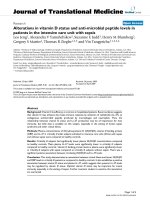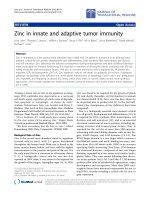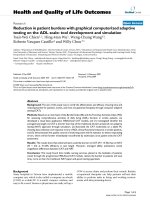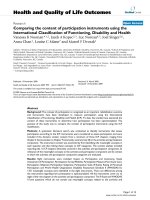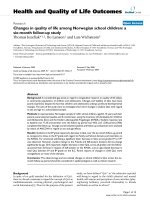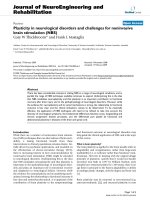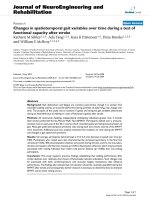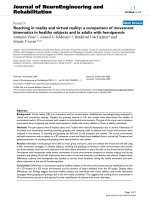báo cáo hóa học: " Change in patient concerns following total knee arthroplasty described with the International Classification of Functioning, Disability and Health: a repeated measures design" docx
Bạn đang xem bản rút gọn của tài liệu. Xem và tải ngay bản đầy đủ của tài liệu tại đây (380.29 KB, 8 trang )
BioMed Central
Page 1 of 8
(page number not for citation purposes)
Health and Quality of Life Outcomes
Open Access
Research
Change in patient concerns following total knee arthroplasty
described with the International Classification of Functioning,
Disability and Health: a repeated measures design
Ravi Rastogi*
1
, Bert M Chesworth
2
and Aileen M Davis
3
Address:
1
Physiotherapist, London Health Sciences Centre, London, Ontario, Canada,
2
Assistant Professor, School of Physical Therapy, Faculty of
Health Sciences and Department of Epidemiology and Biostatistics, Schulich School of Medicine and Dentistry, The University of Western Ontario,
London, Ontario, Canada and
3
Senior Scientist, Health Care and Outcomes Research Division and Arthritis Community Research Evaluation Unit,
Toronto Western Research Institute; Associate Professor, University of Toronto, Toronto, Ontario, Canada
Email: Ravi Rastogi* - ; Bert M Chesworth - ; Aileen M Davis -
* Corresponding author
Abstract
Background: There is no published evidence of how patient concerns change during the first six
weeks following total knee arthroplasty (TKA). An understanding of the recovery process from the
patient's perspective will inform clinicians on how to best educate patients about their post-
operative concerns. Our objectives were to (1) quantify the level of importance for each of 32
previously identified concerns pre-operatively, and across the first six weeks following primary
TKA and, (2) convey this change in importance post-operatively using the components of the
International Classification of Functioning, Disability and Health (ICF).
Methods: The objectives were achieved using a repeated measures design. Convenience sampling
was used to recruit 54 consecutive patients undergoing primary TKA at a hospital in Ontario,
Canada. Pre-operatively and at two, four and six weeks post-operatively subjects rated the level of
importance for each of the 32 previously identified patient concerns
Results: The importance rating of patient concerns in all four ICF components changed from
before surgery to two weeks after surgery. Patient concerns in the Participation component
became increasingly important after the first two weeks following surgery. Post-operatively from
week two to week four, changes in importance ratings were also found in the Body Function and
Activity components, but not in the Environmental Factors component.
Conclusion: Changes in patient concerns mirror their early recovery from TKA surgery.
Consistent with this, Participation restrictions become increasingly important to patients after
discharge from acute care suggesting that clinicians should think of managing patient expectations
for return to societal roles early in post-operative rehabilitation.
Background
Osteoarthritis (OA) of the knee is a common cause of pain
and disability in the elderly population [1]. Depending on
the severity of the disability, total knee arthroplasty (TKA)
has been shown to be an effective procedure in reducing
pain, improving function and quality of life in individuals
Published: 11 December 2008
Health and Quality of Life Outcomes 2008, 6:112 doi:10.1186/1477-7525-6-112
Received: 13 February 2008
Accepted: 11 December 2008
This article is available from: />© 2008 Rastogi et al; licensee BioMed Central Ltd.
This is an Open Access article distributed under the terms of the Creative Commons Attribution License ( />),
which permits unrestricted use, distribution, and reproduction in any medium, provided the original work is properly cited.
Health and Quality of Life Outcomes 2008, 6:112 />Page 2 of 8
(page number not for citation purposes)
suffering from OA of the knee [2,3]. According to the
Canadian Joint Replacement Registry [4], the number of
TKA procedures in Canada increased by more than 100%
from 1994/95 to 2004/05 with two-thirds of all knee
replacements in the 65–84 year age group. As the baby
boomer population approaches this age group, it is
expected that this trend will continue.
When evaluating the success of any treatment, opinions of
patients are of great significance [5]. This is especially
important for elective procedures, such as TKA, which are
normally performed to improve the individual's quality of
life [6]. Different researchers have demonstrated that
patient expectations play an important role in determin-
ing the outcome following TKA [7]. To the extent that
patient expectations and concerns may be related, it is
essential that health care providers appropriately address
concerns that are important to patients to maximize out-
comes following TKA.
Even though patients are routinely referred for physical
therapy in the acute post-operative phase (0–6 weeks)
after TKA, there is no published evidence of how patient
concerns change during this early period of recovery. An
understanding of the recovery process from the patient's
perspective will inform the clinician's approach to patient
education during rehabilitation.
Many of the outcome measures used to quantify change
following primary TKA are based on patients' perceptions
of their status, but the choice of outcomes is rarely
grounded in a conceptual framework [8,9]. The Interna-
tional Classification of Functioning, Disability and Health
(ICF) released by the World Health Organization [10])
provides a unified framework for evaluating health and
health-related states of populations and also provides a
common language for communication among health care
professionals [11,12]. The ICF model includes two parts,
with each part containing separate components. The first
part covers functioning and disability and includes the
components of Body Structure and Function, Activities,
and Participation. The second part covers contextual fac-
tors and includes the components of Environmental Fac-
tors and Personal Factors. The World Health Organization
[10] has indicated that it is difficult to differentiate
between Activities and Participation as defined by the ICF.
Others believe that it is necessary to differentiate between
these components if the ICF is to be widely accepted to
describe functioning in rehabilitation [13,14].
In an earlier study, to identify concerns that patients had
about their recovery from surgery, we performed individ-
ual face-to-face cross-sectional interviews with 30 patients
during the first six weeks following primary TKA for OA.
All patient concerns were identified by asking patients to
answer one specific question, "What is important to you
right now with respect to your recovery from knee replace-
ment surgery?". During the interview it was emphasized
that patients should only identify what was important
during that particular week of the interview. Patients were
allowed to report as many concerns as they wished, all of
which were recorded verbatim in writing. The primary
investigator (RR) conducted all interviews. We grouped
patient comments on the basis of common themes, iden-
tifying 32 concerns about surgical recovery that we then
linked to the components of the ICF [15]. Seven of these
concerns were linked to the Body Function component of
the ICF while 15, 4 and 4 concerns were linked to the
Activity, Participation and Environmental Factors compo-
nents, respectively. Receiving appropriate information
regarding what to expect with rehabilitation following
surgery and being independent were the only two con-
cerns that could not be linked to the ICF. The primary
objectives of this study were to (1) quantify the level of
importance for each of these concerns pre-operatively and
across the first six weeks following primary TKA and, (2)
convey this change in importance post-operatively using
the components of the ICF.
Methods
Participants were English-speaking ambulatory patients
with knee OA who were waiting for a primary TKA. Sam-
ple size calculations were based on a concurrent study of
responsiveness of the WOMAC [unpublished]. Conven-
ience sampling was used to recruit consecutive patients
from the waiting lists of orthopaedic surgeons working in
a large tertiary care hospital. Each subject participated in
four evaluation sessions: pre-operatively and at two, four
and six weeks after surgery. During each evaluation ses-
sion subjects rated the level of importance for each of the
32 concerns identified in our earlier study [15] and were
also given the opportunity to provide additional con-
cerns. Importance was measured on a seven-point scale (1
= not important at all, 2 = important to a very small
extent, 3 = important to a small extent, 4 = important to a
moderate extent, 5 = important to a fairly great extent, 6 =
important to a great extent, 7 = important to a very great
extent). At each evaluation session, subjects also com-
pleted the Numeric Pain Rating Scale (NPRS) [16] and the
Knee Injury and Osteoarthritis Outcome Score (KOOS)
[17] to measure knee-related pain intensity and patient
perceived health status, respectively. The Western Ontario
McMaster Universities Osteoarthritis Index (WOMAC) is
embedded within the KOOS. Therefore, scores for the
subscales of the WOMAC were extracted from the KOOS.
Both the KOOS and the WOMAC have good psychometric
properties and are commonly used to assess patient per-
ceived health status among TKA recipients [17,18]. Demo-
graphic and clinical characteristics including
comorbidities using the Self-Administered Comorbidity
Health and Quality of Life Outcomes 2008, 6:112 />Page 3 of 8
(page number not for citation purposes)
Questionnaire [19] were also captured pre-operatively.
The University of Western Ontario Research Ethics Board
for Health Sciences Research Involving Human Subjects
approved this study.
Analysis
Descriptive statistics were used to summarize the pre-
operative characteristics of subjects. We described change
in clinical status between each time point by evaluating
each subscale of the KOOS with a repeated-measures anal-
ysis of variance (ANOVA) and Bonferroni post-hoc testing
[20]. To quantify how the level of importance changed for
patient concerns during the first six weeks after TKA, the
appropriate measures of central tendency and dispersion
were calculated for each concern at each one of the four
evaluation sessions. To describe change in the importance
ratings using the ICF components we did the following for
each subject at each time point of data collection. We
assigned a single level of importance to each ICF compo-
nent by using the median importance rating from the con-
cerns within that ICF component. To evaluate the change
in this value across time, for each ICF component we con-
ducted a Friedman two-way ANOVA by ranks [21]. The
null hypothesis was that there would be no difference in
the mean rank of importance across time [21]. When a sig-
nificant difference was found, post-hoc testing between
each time point was performed with the Wilcoxon signed-
ranks test [20]. Because four separate nonparametric
ANOVAs were performed and we could potentially per-
form 12 post-hoc tests between time points, we applied
the Bonferroni correction factor [20] and considered p =
0.003 (e.g. 0.05/16) as the threshold for significance.
Results
Fifty-seven subjects were contacted and consented to take
part in the study. One person withdrew from the study
without any explanation and two people did not return
phone calls to set up an appointment, leaving 95% of
recruits who completed the study (n = 54). There were no
missing data. Of the 54 subjects who completed the study,
48% (n = 26) were men. The average age (standard devia-
tion) of the sample was 68.1 (8.9) years. Clinical charac-
teristics of the subjects along with their preoperative
scores for the KOOS, WOMAC and NPRS are shown in
Table 1. Values for the KOOS Function in Daily Living
(ADL) subscale and the WOMAC Function subscale are
identical because the items in the two subscales are the
same. Figure 1 shows the mean scores by time for each
KOOS subscale. The KOOS scores can range from 0–100
with 100 indicating best state. The ANOVA results indi-
cated significant change over time for all subscales (p <
0.0001). Post hoc testing confirmed significant changes in
the Pain and Knee-related Quality of Life (QOL) subscales
only beyond two weeks following surgery (p = 0.01 to p <
0.0001). The ADL and Function in Sport and Recreation
(Sport/Rec) subscales changed significantly in each 2-
week period (p = 0.01 to p < 0.0001). Significant change
in the Symptoms subscale was found between four and six
weeks after surgery (p = 0.02).
As mentioned earlier, during each evaluation session sub-
jects were given the opportunity to identify any additional
concerns regarding their recovery from knee replacement
surgery. No additional concerns were provided by subjects
at any of the four evaluation sessions. On visual inspec-
tion, the importance ratings for the 32 concerns identified
in our earlier study [15] were skewed. Therefore the
median and first and third quartiles were used to summa-
rize the distribution of these ratings. Tables 2, 3, 4 show
these values across time for each concern within an ICF
component. They show that before surgery, most con-
cerns had relatively high importance ratings, with some
remaining fairly stable after surgery and others changing
more dramatically over time. Median levels of importance
Table 1: Pre-operative subject characteristics (n = 54).
Walking aid, n(%)
None 32 (59)
Cane 15 (28)
Four wheeled walker 7 (13)
Number of comorbidities, median(Q
1
-Q
3
)*min- max
†
3 (2–4) 1–6
Five most prevalent comorbidities, n(%)
High Blood Pressure 32 (59)
Back Pain 24 (44)
Diabetes 15 (28)
Heart Disease 12 (22)
Depression 10 (19)
KOOS subscale scores§ mean (SD
‡
)
Pain 46.9 (15.1)
Symptoms 48.4 (14.9)
ADL 48.3 (16.9)
Sport/Rec 11.5 (14.6)
QOL 21.6 (14.5)
WOMAC subscale scores§ mean (SD)
Pain 51.5 (16.4)
Stiffness 41.4 (16.6)
Function 48.3 (16.9)
Numeric Pain Rating Scale
||
, mean (SD), min-max 6.4 (2.1) 1–10
* (Q1-Q3) = 25
th
to 75
th
percentile
†
min-max = minimum to maximum
‡
SD = Standard deviation
§
KOOS = Knee Injury and Osteoarthritis Outcome score: subscales
are Pain, other Symptoms, function in daily living (ADL), function in
sport and recreation (Sport/Rec) and knee-related Quality of life
(QOL). WOMAC = Western Ontario and McMaster Universities
Osteoarthritis Index: subscales are Pain, Stiffness and Function.
Subscale scores can vary from 0–100 with 100 indicating the best
state
||
Values on the scale can vary from 0 = no pain to 10 = worst possible
pain
Health and Quality of Life Outcomes 2008, 6:112 />Page 4 of 8
(page number not for citation purposes)
for the two concerns that were not covered by the ICF
(receiving appropriate information regarding what to
expect with rehabilitation following your surgery and
being independent) had high levels of importance at all
four time points (i.e. either 6 or 7 on the 7-point scale).
The Friedman's ANOVA results are shown in Figure 2. The
mean rank of the importance rating changed over time (p
< 0.0001) for all four ICF components (Body Function:
χ23df = 34.29; Activity: χ23df = 20.61; Participation:
χ23df = 90.91; Environmental Factors: χ23df = 14.37).
Post-hoc testing revealed a significant change in impor-
tance between the pre-operative evaluation and post-
operative week two for all four ICF components (p <
0.0001). Participation was the only ICF component that
demonstrated a significant change in importance between
all four-time points (p < 0.0001). The importance of the
Body Function and Activity components changed signifi-
cantly from before surgery through to post-operative week
four (p < 0.001).
Discussion
This study was conducted to gain a quantitative under-
standing of how the importance of patient concerns
change during the first six weeks following primary TKA.
It showed that the importance of some concerns change
Average KOOS* score grouped by subscale: pre-operatively (pre-op) and two, four and six weeks after (post-op) primary total knee arthroplasty (n = 54)Figure 1
Average KOOS* score grouped by subscale: pre-operatively (pre-op) and two, four and six weeks after (post-
op) primary total knee arthroplasty (n = 54). * KOOS = Knee Injury and Osteoarthritis Outcome score: subscales are
Pain, other Symptoms, function in daily living (ADL), function in sport and recreation (Sport/Rec) and knee-related Quality of
life (QOL). Subscale scores can vary from 0–100 with 100 indicating the best state.
Table 2: Importance levels for patient concerns linked to the ICF* Body Function component: pre-operatively (pre-op) and two, four
and six weeks after knee arthroplasty (n = 54)
Patient Concern Pre-op Week 2 Week 4 Week 6
Decreasing pain in your surgical knee 6 (5–7)
†
7 (6–7) 6 (5–7) 6 (4–6)
Reducing the swelling in your surgical leg 3 (1–6) 6 (5–7) 6 (5–7) 5 (3–6)
Avoiding infection in your surgical knee 2 (1–7) 7 (6–7) 5 (2–7) 3 (1–6)
Sleeping better at night 5 (4–7) 6 (5–7) 6 (5–7) 6 (4–7)
Increasing the bend in your surgical knee 4 (2–6) 7 (6–7) 6 (5–7) 6 (5–7)
Increasing the straightening in your surgical knee 4 (1–5) 6 (5–7) 5 (4–6) 6 (3–6)
Increasing the strength in your legs 6 (4–7) 6 (5–7) 6 (5–7) 6 (5–6)
* International Classification of Functioning, Disability, and Health
†
median (25
th
to 75
th
percentile); importance ratings are on a 7-point scale (1 = not important, 7 = important to a very great extent)
Health and Quality of Life Outcomes 2008, 6:112 />Page 5 of 8
(page number not for citation purposes)
over time while others do not. In the discussion that fol-
lows we suggest these changes reflect the clinical aspects of
the delivery of care and the early recovery process. We also
propose that the importance ratings provide direct evi-
dence that supports the differentiation of the Activity and
Participation components of the ICF in the clinical con-
text of this study. To the best of our knowledge, this is the
first study of this nature.
The Friedman's ANOVA revealed the importance rankings
of all four ICF components changed over time. Post hoc
testing showed that concerns in the ICF Body Function
component were ranked higher at post-operative week
two compared to before surgery. The WHO has defined
Body Function [10] as physiological functions of the body
systems including psychological functions. Following
major joint surgery such as TKA, physiological functions
perceived as important by patients, such as motion of the
knee joint, strength in the lower extremities and sleeping
at night are commonly impaired for the first month post-
operatively [6]. The sensation of pain and swelling in the
surgical leg are also common occurrences during this
phase of post-operative recovery. Presence of these
impairments after surgery would naturally cause discom-
fort and limit normal daily activities. Consistent with this
logic, patients in this study rated these Body Function con-
cerns as being more important to them in the first month
following surgery.
Going through surgery and recovery may also explain the
pattern of change in the Activity and Participation impor-
tance ratings. Post hoc testing showed that patients ranked
concerns in these components as being less important two
weeks after surgery. Due to the nature of the surgery it is
Table 3: Importance levels for patient concerns linked to the ICF* Activity component: pre-operatively (pre-op) and two, four and six
weeks after knee arthroplasty (n = 54)
Patient Concern Pre-op Week 2 Week 4 Week 6
Getting out of bed on your own 4.5 (3–7) 6 (5–7) 5 (3–6) 5 (3–7)
Getting in/out of bath 5 (3–7) 1 (1–4) 5 (3–6) 4 (2–6)
Putting on your own shoes or socks 5 (3–6) 6 (4–7) 5 (4–6) 5 (4–6)
Dressing yourself 4 (2–6) 5.5 (4–7) 5.5 (4–6) 6 (4–7)
Walking on a flat surface 5 (4–7) 6 (5–7) 6 (4–7) 6 (4–7)
Walking on uneven ground 5 (3–7) 1 (1–3) 3 (1–5) 4 (3–6)
Descending stairs 6 (4–7) 3.5 (1–6) 5 (3–6) 5 (4–6)
Ascending stairs 6 (5–7) 4 (1–6) 5 (3–6) 5 (4–6)
Cooking your own meals 5 (2–7) 1 (1–3) 4 (2–6) 4 (2–6)
Doing your own housework 5 (3–6) 1 (1–3) 3 (2–6) 4 (2–6)
Heavy domestic duties 2.5 (1–6) 1 (1–1) 1 (1–2) 1 (1–3)
Light domestic duties 4 (3–6) 2 (1–3) 4 (3–5) 4.5 (3–6)
Getting in/out of car 6 (4–7) 4 (2–6) 6 (4–7) 6 (5–7)
Comfortably sit in car 5 (3–6) 4 (2–6) 6 (4–6) 5.5 (4–6)
Doing your exercises as prescribed by your PT 4 (1–7) 7 (6–7) 6 (6–7) 6 (5–7)
* International Classification of Functioning, Disability, and Health
†
median (25
th
to 75
th
percentile); importance ratings are on a 7-point scale (1 = not important, 7 = important to a very great extent)
Table 4: Importance levels for patient concerns linked to ICF* Participation and Environmental Factors components: pre-operatively
(pre-op) and two, four and six weeks after knee arthroplasty (n = 54)
Patient Concern by ICF component Pre-op Week 2 Week 4 Week 6
Participation
Driving a vehicle 6 (3–7) 1 (1–1) 1 (1–4) 3.5 (1–6)
Going shopping 5 (3–6) 1 (1–1) 3 (1–5) 4 (3–6)
Returning to your hobbies 5 (2–7) 1 (1–2) 2 (1–3) 3 (1–5)
Going back to your regular exercise class or sport 4 (1–7) 1 (1–1) 1 (1–4) 3 (1–6)
Environmental factors
Being less of a burden on your spouse or caregiver 6 (4–7) 6 (5–7) 6 (5–7) 6 (5–7)
Having the support of your family members 6 (5–7) 6 (6–7) 6 (5–7) 6 (5–7)
Having the support of your neighbours 3 (1–5) 3 (1–5) 4 (1–5) 4 (1–6)
Receiving competent care from health care workers in a timely manner 2.5 (1–6) 7 (6–7) 6 (5–7) 6 (4–7)
* International Classification of Functioning, Disability, and Health
†
median (25
th
to 75
th
percentile); importance ratings are on a 7-point scale (1 = not important, 7 = important to a very great extent)
Health and Quality of Life Outcomes 2008, 6:112 />Page 6 of 8
(page number not for citation purposes)
common for patients to experience impairments with cer-
tain body functions (increased pain and swelling,
decreased knee range of motion, impaired sleep), which
generally lead to limitations in the activities that they can
perform. Researchers have reported a decline in physical
function in the first month following TKA surgery [6].
Consistent with this, patients in our study demonstrated
significant decreases in the KOOS ADL and Sport/Rec sub-
scales in the first two weeks after surgery. Due to this
decline, concerns from the ICF Activity component (e.g.
'walking on uneven ground', 'cooking your own meals',
'doing your own housework') and concerns from the Par-
ticipation component (e.g. 'driving a vehicle', 'shopping'
or 'returning to hobbies') dropped in importance during
the first two weeks post-operatively. Their subsequent
increase in importance to pre-operative levels after sur-
gery, may reflect the fact that patients are generally starting
to feel better, are mobilizing with greater ease and are
becoming less dependent on their caregivers. Indeed,
Kennedy and colleagues [22] and Stratford and Kennedy
[23] found that physical function improved to pre-opera-
tive levels by post-operative week six to eight. Again, con-
sistent with this, patients in our study showed significant
increases in the KOOS ADL and Sport/Rec subscales from
two weeks through to six weeks post-operatively. The
importance ratings for Body Function, Activity and Partic-
ipation, combined with parallel changes in these KOOS
subscale scores therefore, supports the validity of these
concerns and their importance to patients because they
mirror the surgical and early rehabilitation focus.
Just like the Body Function component, patient concerns
that mapped to the Environmental Factors component
were ranked higher two weeks after surgery. Due to the
immediate decline in physical function [6], patients
require the support of family members and health care
workers to help them manage with daily activities and
restore their physical function. Consistent with this, con-
cerns such as 'having the support of your family mem-
bers', 'receiving competent care from health care workers'
and 'being less of a burden on your spouse or caregiver'
were important to patients during this acute post-opera-
tive phase of their recovery. 'Having the support of your
neighbours' was the only concern mapping to the Envi-
ronmental Factors component that was of moderate to
small importance at each post-operative evaluation ses-
sion. This may relate to the fact that TKA is an elective sur-
gery, which allows the patient time to plan for their post-
operative needs using alternative resources (home care,
family members etc.) and therefore, not requiring the sup-
port of their neighbours.
Two concerns that were not covered by the ICF compo-
nents, 'receiving appropriate information regarding what
to expect with rehabilitation following your surgery' and
'being independent' were of great importance to patients
Average rank of importance for patient concerns grouped by ICF* component: pre-operatively (pre-op) and two, four and six weeks after (post-op) primary total knee arthroplasty (n = 54)Figure 2
Average rank of importance for patient concerns grouped by ICF* component: pre-operatively (pre-op) and
two, four and six weeks after (post-op) primary total knee arthroplasty (n = 54). * International Classification of
Functioning, Disability, and Health
Health and Quality of Life Outcomes 2008, 6:112 />Page 7 of 8
(page number not for citation purposes)
before surgery and remained at the same level of impor-
tance throughout the first six weeks of recovery. The first
emphasizes the importance of education from the patient
perspective. In this regard, Soever and MacKay [24] have
documented that receiving information about their reha-
bilitation is important to patients and that this type of
education improves patient satisfaction following total
joint replacement surgery. The second highlights the con-
sistently high value that patients place on independence.
Hinojosa and Youngstrom have reported that "independ-
ence is defined by the individual's culture and values, sup-
port systems, and ability to direct his or her life" [25].
Gignac and Cott [26] have reported that a loss of inde-
pendence may have consequences on the quality of life
and psychosocial well being of an individual. The cultural
background of patients in this study and the support sys-
tem in our society along with the consequences of losing
independence, may explain why patients consistently
rated the importance of this concern so high, throughout
the first six weeks of recovery.
There is considerable debate regarding the need to distin-
guish between the Activity component and the Participa-
tion component of the ICF [12-14,27]. While the WHO
decided not to distinguish between these two compo-
nents; others have stressed the importance of their differ-
entiation if the ICF is to be widely used when describing
health and health-related states of various populations
across the world [12-14]. The results of this study high-
light the challenge one faces in differentiating the ICF
Activity and Participation components. On one hand, the
average ranking of importance across time for these two
components (Figure 2) reveals a similar pattern over time,
suggesting there is little to be gained from separation of
the ICF components when describing the importance of
patient concerns about recovery. On the other hand, the
relatively low values in the KOOS Sport/Rec subscale (Fig-
ure 1) may explain the pattern in Participation concerns
after the two-week mark following surgery. Only those
concerns in the ICF Participation component showed
consistent increases in their level of importance through
the first six weeks after surgery. We believe this highlights
one tangible benefit from separating the two components
in the context of this work: patients are starting to think
about their return to participation in roles early in the
recovery phase. As evidenced by the KOOS Sport/Rec sub-
scale, they are also aware of their limitations in Participa-
tion-related activities. This is important for the clinician to
note as researchers have shown that patient expectations
are a predictor of functional outcome and satisfaction fol-
lowing total joint replacement surgery [28]. Therefore,
patient education should encompass return to participa-
tion roles very soon after surgery and in particular, should
re-evaluate participation-related goals from two to six
weeks of postoperative care. Future studies should deter-
mine if the increasing importance assigned to Participa-
tion concerns in this study continues to increase beyond
the six-week mark post-operatively.
All participants in the study were recruited from a single
tertiary care hospital. This may be viewed as decreasing
the generalizability of this study to other settings. Even
though the results may not be applicable to all TKA pop-
ulations, the patient demographics and pre-operative
functional status findings were comparable to that of
other TKA studies [17,29-31]. The rehabilitation setting
(e.g. home care, in-patient or out-patient facilities) fol-
lowing surgery may influence what is important to
patients. The majority of patients in this study received
their initial therapy at home after acute care discharge
until approximately three weeks following surgery. Then
they continued therapy at an out-patient clinic of their
choice. Therefore, it is possible that patients undergoing
TKA, who receive therapy in a different setting than
described above may have different priorities and con-
cerns during the first six weeks following surgery. We note
however that no subjects in this study provided additional
concerns when given the opportunity to do so at four dif-
ferent time points of data collection. Furthermore, when
the importance findings are viewed in combination with
the KOOS data, changes in patient concerns mirrored the
early recovery pattern from TKA surgery. This supports the
validity of the concerns we investigated and combined
with the finding that importance levels varied over time,
suggests a temporal element that should be included in
future work of this nature. As there was no test-retest com-
ponent in this study, reliability of the importance ratings
at each time point of data collection could not be con-
firmed. Another limitation of this study was the inability
to include non-English speaking individuals. Therefore,
the results are not applicable to non-English speaking
recipients of TKA surgery. Finally, our sample size for this
study was based on sample size calculations of a concur-
rent study of responsiveness of the WOMAC [unpub-
lished]. This seemed acceptable because we had no
previous importance ratings on which to base our sample
size calculations. Where no significant differences were
found, it may be possible the study was underpowered.
Conclusion
In conclusion the study shows the level of importance that
patients assign to concerns about recovery from TKA sur-
gery, is a reflection of the stage they are in, during the sur-
gical and rehabilitation process. In particular,
Participation restrictions become increasingly important
to patients from two to six weeks after surgery, suggesting
that patients do think about their return to activities at the
societal level early in their postoperative rehabilitation.
Clinicians can use this knowledge to integrate their
approach to education, goal setting and managing expec-
Health and Quality of Life Outcomes 2008, 6:112 />Page 8 of 8
(page number not for citation purposes)
tations about return to participation roles after TKA sur-
gery.
Competing interests
The authors declare that they have no competing interests.
Authors' contributions
RR, AMD and BMC designed the study. RR collected and
analyzed the data and drafted the manuscript with regular
feedback from AMD and BMC. All authors read and
approved the final manuscript.
Acknowledgements
This work was supported by a Premier's Research Excellence Award from
the Ontario Ministry of Health and Long-term Care to Dr. Davis and by the
Dr. Jal Tata Research Award from the London district of the Ontario Phys-
iotherapy Association to Ravi Rastogi.
The study was completed by Ravi Rastogi in partial fulfilment of the require-
ments for the degree of Master of Science at the School of Physical Ther-
apy, The University of Western Ontario.
References
1. Davis MA, Ettinger WH, Neuhaus JM, Mallon KP: Knee osteoarthri-
tis and physical functioning: Evidence from the NHANES I
epidemiologic followup study. J Rheumatol 1991, 18:591-598.
2. Hartley RC, Barton-Hanson NG, Finley R, Parkinson W: Early
patient outcomes after primary and revision total knee
arthroplasty. J Bone Joint Surg [Br] 2002, 84:994-999.
3. Heck DA, Robinson RL, Partridge CM, Lubitz R, Freund DA: Patient
outcomes after knee replacement. Clin Orthop Relat Res 1998,
1:93-110.
4. Canadian Institute for Health Information (CIHI): Canadian Joint
Replacement Registry (CJRR). Hip and Knee Replacements in Can-
ada 2006. Report.
5. Dickstein R, Heffes Y, Shabtai E, Markowitz E: Total knee arthro-
plasty in the elderly: Patients' self-appraisal 6 and 12 months
postoperatively. Gerontology 1998, 44:204-210.
6. Salmon P, Hall GM, Peerbhoy D, Shenkin A, Parker C: Recovery
from hip and knee arthroplasty: Patients' perspective on
pain, function, quality of life and well-being up to 6 months
postoperatively. Arch Phys Med and Rehabil 2001, 82:360-366.
7. Noble PC, Conditt MA, Cook KF, Mathis KB: The John Insall
Award: Patient expectations affect satisfaction with total
knee arthroplasty. Clin Orthop Relat Res 2006, 452:35-43.
8. McFarlane A, Brooks P: The assessment of disability and handi-
cap in musculoskeletal disease. J Rheumatol 1997,
24(5):985-989.
9. Newman S: Psychosocial measures in musculoskeletal trials. J
Rheumatol 1997, 24(5):979-984.
10. World Health Organization: International Classification of Func-
tioning, Disability and Health. 2001.
11. Stucki G, Cieza A, Ewert T, Kostanjsek N, Chatterji S, Ustun TB:
Application of the International Classification of Function-
ing, Disability and Health (ICF) in clinical practice. Disabil
Rehabil 2002, 24:281-282.
12. Whiteneck G: Conceptual models of disability: past, present,
and future. Workshop on Disability in America: A new look
– summary and background papers. Edited by: Field MJ, Jette
AM, Martin L. The National Academic Press, Washington DC; 2006.
Appendix B:50-66.
13. Jette AM, Haley SM, Kooyoomjian JT: Are the ICF activity and
participation dimensions distinct? J Rehabil Med 2003,
35:145-149.
14. Perenboom RJM, Chorus AMJ: Measuring participation accord-
ing to the International Classification of Functioning, Disabil-
ity and Health (ICF). Disabil Rehabil 2003, 25:577-587.
15. Rastogi R, Davis AM, Chesworth BM: Patient concerns in the first
six weeks following primary total knee arthroplasty. Health
Qual Life Outcomes 2007, 5:48. doi: 10.1186/1477-7525-5-48.
16. Farrar JT, Young JP Jr, LaMoreaux L, Werth JL, Poole RM: Clinical
importance of changes in chronic pain intensity measured on
an 11-point numerical pain rating scale. Pain 2001, 94:149-158.
17. Roos EM, Toksvig-Larsen S: Knee injury and osteoarthritis out-
come score (KOOS) – validation and comparison to the
WOMAC in total knee replacement. Health Qual Life Outcomes
2003, 1:17-26.
18. Ethgen O, Bruyere O, Richy F, Dardennes C, Reginster J-V: Health-
related quality of life in total hip and total knee arthroplasty.
A qualitative and systematic review of the literature. J Bone
Joint Surg [Am] 2004, 86(5):963-74.
19. Sangha O, Stucki G, Liang MH, Fossel AH, Katz JN: The self-admin-
istered comorbidity questionnaire: A new method to assess
comorbidity for clinical and health services research. Arthritis
Care Res 2003, 49:156-163.
20. Portney LG, Watkins MP: Foundations of Clinical Research:
Applications to Practice. 2nd edition. New Jersey; Prentice Hall
Health; 2000.
21. Winer BJ: Single-factor experiments having repeated meas-
ures on the same elements. In Statistical principles in experimental
design 2nd edition. New York: McGraw-Hill Book Company;
1971:261-308.
22. Kennedy DM, Stratford PW, Wessel J, Gollish JD, Penney D: Assess-
ing stability and change of four performance measures: a lon-
gitudinal study evaluating outcome following total hip and
knee arthroplasty. BMC Musculoskelet Disord 2005, 6:3-14.
23. Stratford PW, Kennedy DM: Performance measures were nec-
essary to obtain a complete picture of osteoarthritic
patients. J Clin Epidemiol 2006, 59:160-167.
24. Soever L, Mackay C: Best practices across the continuum of
care for total joint replacement. Greater Toronto Area Rehabilita-
tion Network. Final Report 2005.
25. Hinojosa J, Youngstrom MJ: Position paper: broadening the con-
struct of independence. Am J Occup Ther 2002, 56(6):660.
26. Gignac MA, Cott C: A conceptual model of independence and
dependence for adults with chronic physical illness and disa-
bility. Soc Sci Med 1998, 47(6):739-753.
27. Dahl TH: An introduction and discussion of its potential
impact on rehabilitation services and research. J Rehabil Med
2002, 34:201-204.
28. Mahomed NN, Liang MH, Cook EF, Daltroy LH, Fortin PR, Fossel AH,
Katz JN: The importance of patient expectations in predicting
functional outcomes after total joint arthroplasty. J Rheumatol
2002, 29(6):1273-1279.
29. Stratford PW, Kennedy DM, Hanna SE: Condition-specific West-
ern Ontario McMaster Osteoarthritis Index was not superior
to region-specific Lower Extremity Functional Scale at
detecting change. J Clin Epidemiol 2004, 57:1025-1032.
30. Bachmeier CJM, March LM, Cross MJ, Lapsley HM, Tribe KL, Courte-
nay BG, Brooks PM: A comparison of outcomes in osteoarthri-
tis patients undergoing total hip and knee replacement
surgery. Osteoarthritis Cartilage 2001, 9:137-146.
31. Lingard EA, Katz JN, Wright RJ, Wright EA, Sledge CB, Kinemax Out-
comes group: Validity and responsiveness of the Knee Society
Clinical Rating System in comparison with the SF-36 and
WOMAC. J Bone Joint Surg [Am] 2001, 83:1856-1864.

